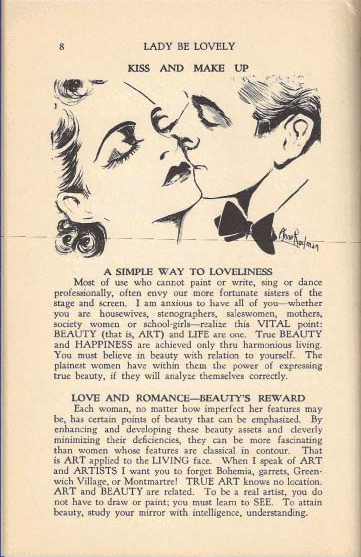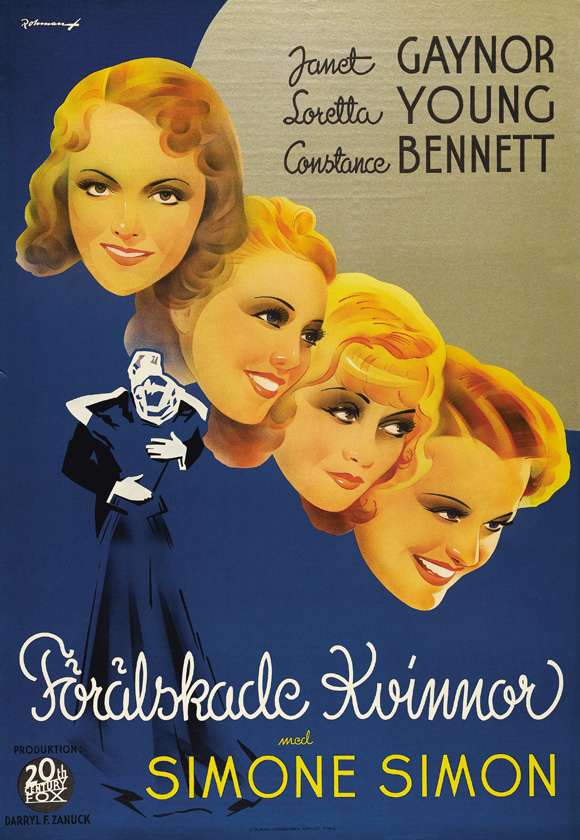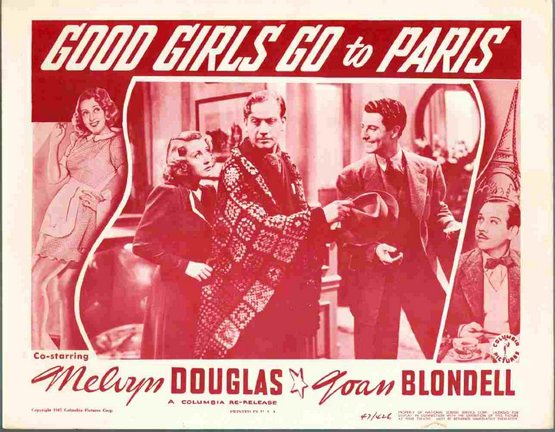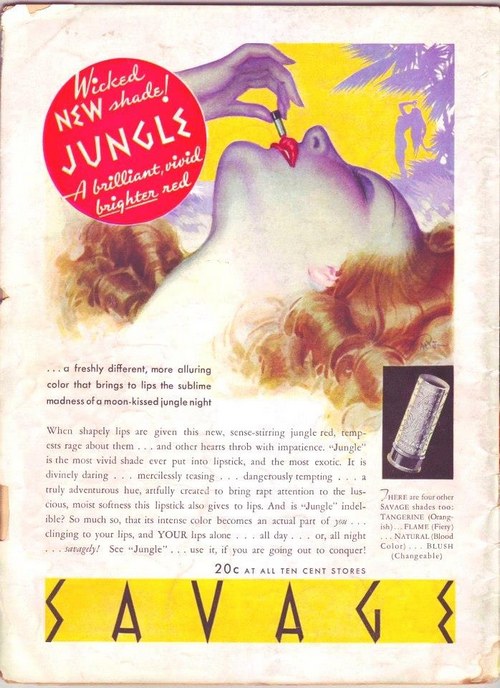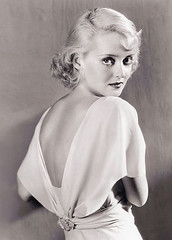Sat 5 Mar, 2016
Fri 26 Feb, 2016
Vintage Powder Room Cinema
Comments (0) Filed under: Vintage Powder Room CinemaTags: 1939, Joan Blondell, Melvyn Douglas
Welcome to Vintage Powder Room Cinema! This week’s feature is GOOD GIRLS GO TO PARIS [1939] starring Melvyn Douglas and Joan Blondell.
TCM says:
Ronald Brooke, an English exchange professor at a Midwestern college, is astounded at waitress Jenny Swanson, whose ambition is to gold-dig her way to Paris. Jenny begins to realize her dream when Ted Dayton, the son of a millionaire, hits her with his car and she entices him into a marriage proposal. When her conscience prevents her from going through with a breach of promise suit, Ronnie counsels her that good girls go to Paris too.
Is the professor right? Do good girls really get to Paris? Watch and find out!
Tue 19 Aug, 2014
A Savage Supply; The Mysterious Origins of Jungle Red, 1936
Comments (0) Filed under: Adam, Advertisements, Vintage Powder Room CinemaTags: 1939, Joan Crawford, Jungle Red, Norma Shearer, Rosalind Russell
At the end of the witty, bitchy, superbly filmed MGM classic of 1939, ” The Women”, a sadder yet wiser Mary Haines poses dramatically in her sumptuous white satin bedchamber, dons a lame gown similar in style to one that her husbands new wife/former mistress Crystal Allen once modeled for her and utters the immortal lines, ” I’ve had t…wo years to grow claws mother- Jungle Red!”
It’s an unforgettable moment and Norma Shearer plays it with just the right amount of humor and vitriol–she’s nobody’s fool and absolutely her own woman.
So where did the actual oft-mentioned siren shade originate? Although it’s suggested at a swanky Manhattan beauty establishment at the beginning–(Sydney’s by name), it is also applied by a somewhat vulgar, gossipy manicurist–Olga who was fired from Black’s Fifth Avenue sometime earlier.
Scarlet nails were considered somewhere between appealing and appalling at the time; some men reveled in needling wives, sweethearts and mistresses with,. ” You’re hands look as if they were dripping blood.” Echoing these sentiments cinematically is the lone masculine voice of acerbic writer Peggy (who is usually read as a lesbian), when she turns to viper-tongued Sylvia and states. ” You look as if you had been cutting somebody’s throat.”
This resplendent ravishingly and risqué image appeared on the back pages of the surprising, ‘Popular Song’ sometime prior to either the original play or the later film.
Boldly featuring the announcement of a wicked new shade for lips and fingernails- Jungle is feverishly described as vivid, brighter–willingly able to make you into the most disarmingly dangerous dame this side of the south seas.
This would have been the kind of makeup that girls, likely from poor or working class backgrounds would favor. It was meant to suggest in no uncertain terms that the brand and the shade were capable of making the wearer irresistible glamorous daring, an almost volcanically intense object of desire.
Bringing this back into the film–this all makes perfect sense. Duplicitous, disastrously loud-mouthed, gossip-ridden beastly blabber-mouthed, Sylvia Fowler suggests the shade after hearing a racy tale regarding Mary Haines perfect paragon (tall, fair distinguished’ an engineer), of a husband, realizing the second Mary puts on a coat or two of the tantalizing polish, the whole gruesome story will pour forth. It’s the first of two cinematic examples of how this shade is also a weapon; it leads to harmful gossip, that literally rips apart a supposedly elegantly ideal marriage.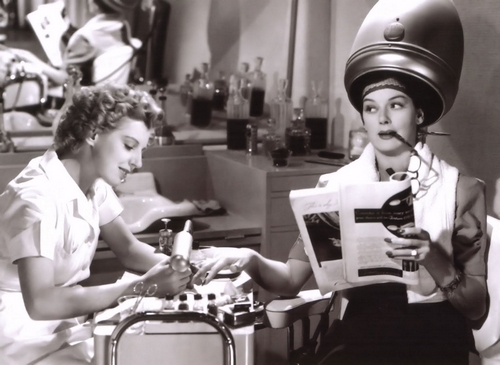
Jungle Red, our newest color was new in 1936 and seen to provocative excess in the kind of magazine (Screen Stories, True Confessions, Popular Song), that a manicurist or a shop girl would be likely to read.
The shade Jungle and brand name, Savage, would have been sold in the five and dime, or the local drug-store thus equating in, in thirties parlance as common, vulgar and most definitely cheap. Each of these qualities is exactly what those untrustworthy supposedly straight-arrow spouses seem to fall for- a duo of the leads looses her man to respectively a shopgirl and a chorus dame!
Mystery solved.
–Adam
Wed 28 Jul, 2010
Lady, Be Lovely — Beautiful Bosoms
Comments (0) Filed under: BooksTags: 1939, Anne Rodman, brassiere, Dita von Teese, plastic surgery, Wonderbra
It’s been too long since we last visited Anne Rodman’s 1939 beauty advice book, “Lady, Be Lovely”. I decided to turn the page today and see what my favorite beauty authority would have in store. I was delighted to find information on how to have beautiful bosoms, back, and shoulders.
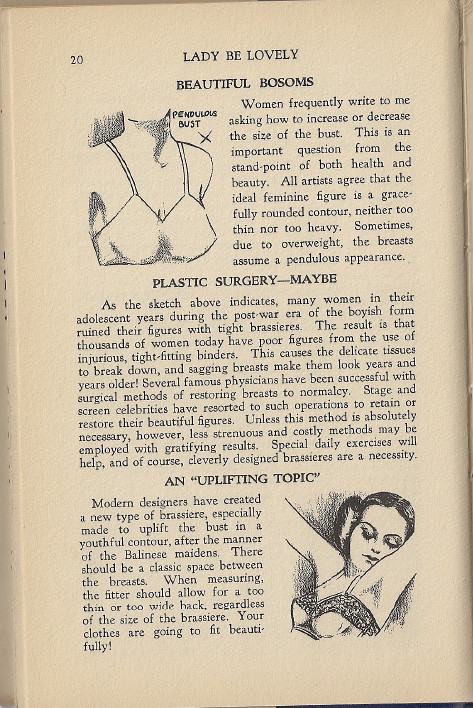
Anne makes a case for plastic surgery for a woman’s breasts but only if, as she states, it is absolutely necessary. Her preference is for an uplifting brassiere. Things don’t appear to have changed much since the publication of “Lady, Be Lovely” — women are still pursuing pefect breasts. I believe that Anne would approve of Dita Von Teese’s choice of underpinnings and, like the rest of us, be envious of her incredible form.

Dita Von Teese in a Wonderbra
And what about the “…youthful contour, after the manner of the Balinese maidens” Anne mentioned? Below are “Two Balinese Maidens” by Theo Meier, and I’d say that “youthful contour” is an understatement.
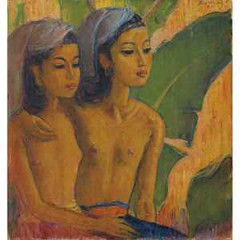
Two Balinese Maidens
In the 1930s a beautiful back was crucial if a woman wanted to follow the trend in evening gowns. Bette Davis looked stunning in her frock. She had the back and shoulds to make the most of it.
According to Ms. Rodman, a woman could achieve a beautiful back by stretching backward over a hassock.

Now, according to a woman’s magazine, we can have a ball!
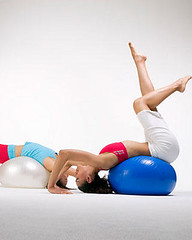
I’ll see you at the gym!
Sun 4 Apr, 2010
Lady, Be Lovely: Symmetry is Beauty
Comments (0) Filed under: BooksTags: 1939, exercise, Rubens, symmetry, Venus de Milo
According to Anne Rodman, no matter what your figure you MUST exercise. I couldn’t agree more. In fact tomorrow morning I’ll be at the gym for a spinning class, followed by Pilates.
If I’m not symmetrical, it’s not for lack of trying.

Sun 4 Apr, 2010
Lady, Be Lovely: Weekends at the Milk Farm
Comments (0) Filed under: BooksTags: 1930s, 1939, health spa, liquid diet, Milk Farm
Health spas and liquid diets aren’t new phenomenons, so it isn’t surprising that Anne Rodman would spend a few paragraphs on them.
I think a few days at a Milk Farm are exactly what I need.

Sun 4 Apr, 2010
Lady, Be Lovely: Wake Up and Dance!
Comments (0) Filed under: BooksTags: 1939, dancing with the stars, lady be lovely, weight loss
Most of the celebrities who have appeared on “Dancing with the Stars” have said that they’ve lost weight. Anne Rodman, author of “Lady, Be Lovely”, knew as much in 1939.
Here’s what she had to say about dancing your way to beauty.
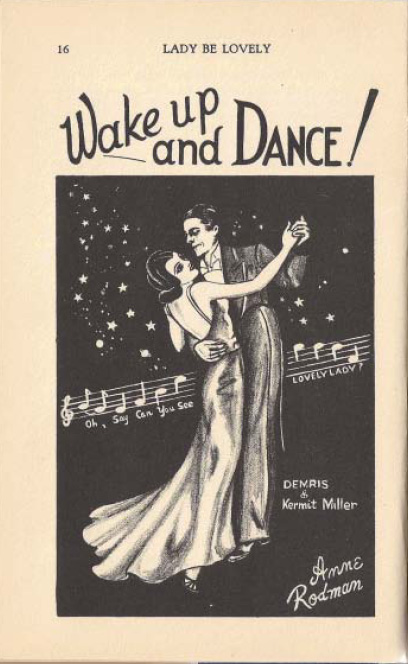
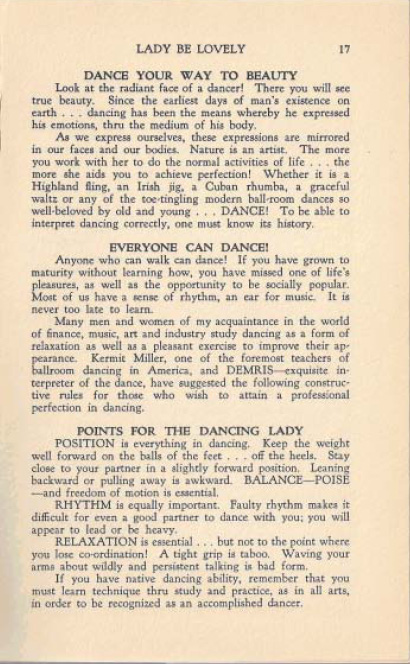
So, ladies, get up off of the sofa and shake it!
Fri 18 Dec, 2009
Lady, Be Lovely – Your Ideal Figure
Comments (0) Filed under: BooksTags: 1939, Anne Rodman, bon bons, diet, exercise
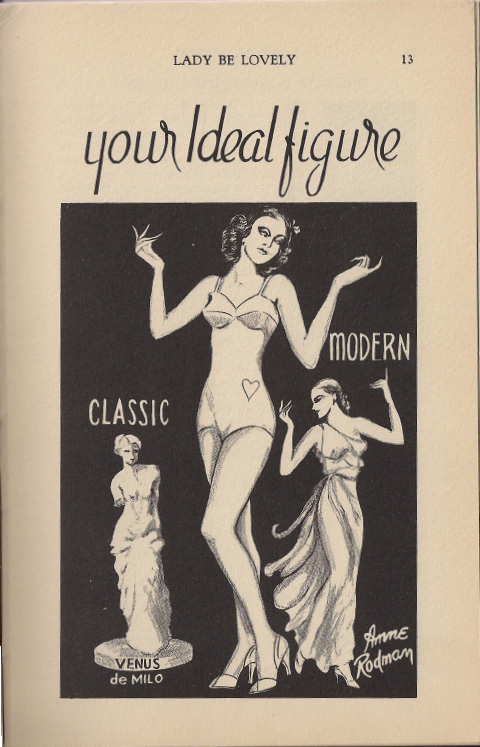
Okay, ladies, drop the bon-bons and step away from the extra helping of pie. I know, it’s holiday time and everyone seems to ignore their diets in favor of partying; but I don’t think that Anne Rodman, author of “Lady, Be Lovely, would approve.
Instead of packing on those extra 5-10 pounds this season, focus on your ideal figure and you will begin the new year svelte and gorgeous!
Here are a few tips for attaining, and maintaining, your ideal figure.
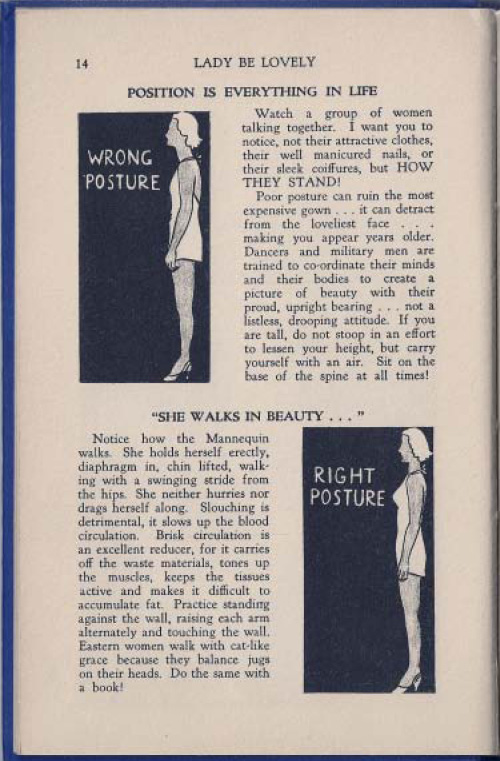
See, your mother was right — Stand Up Straight!
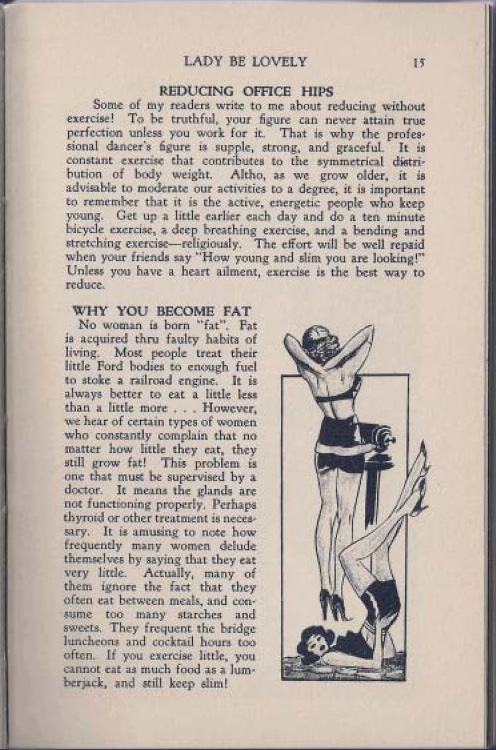
So, to sum up, don’t eat between meals, and beware those frequent bridge luncheons and cocktail hours! As Anne says, “…you cannot eat as a lumberjack, and still keep slim!”
Tue 10 Nov, 2009
Lady, Be Lovely — A Matter of Viewpoint
Comments (0) Filed under: UncategorizedTags: 1930s, 1939, Duchess of Windsor, Wallis Simpson

I confess, once I started paging through “Lady, Be Lovely”, I couldn’t wait to post a few more pages from that delightful book.
Today we’ll learn, among other things, that beauty has a viewpoint, that the queen of beauty is love, and how to be courageous.
There’s also a quote from the sanskrit, accompanied by a drawing that is obviously Wallis Simpson, the Duchess of Windsor. I will devote more time to the Duchess in a future post on unconventional beauty.
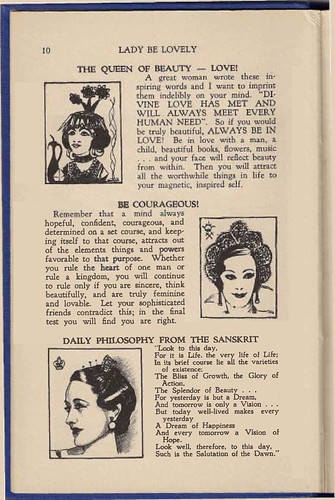
Mon 9 Nov, 2009
Lady, be Lovely
Comments (0) Filed under: UncategorizedTags: 1930s, 1939, Adrian, Anita Loos, Anne Rodman, Cedric Gibbons, Claire Booth Luce, Jane Murfin, NARS, The Women
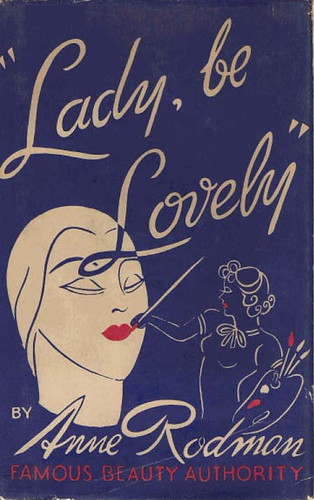
I have an extensive collection of books on every subject of feminine interest from vintage fashion to cosmetics. One of my favorites is “Lady, be Lovely” by Anne Rodman, published in 1939. According to the introduction Anne worked as a copy writer for some of the leading cosmetics firms in the U.S. She also had a background in commercial art. Taking as her inspiration the notion that beauty could be taught to women from the viewpoint of an artist, she began to create “before and after” cartoons so that “a woman could see at a glance how to improve her appearance, just as if she were seated before the mirror of the best salon expert on Fifth Avenue.” What a wonderful concept!
Anne Rodman’s book reminds me of the film “The Women“. Both the book and the film were released in 1939 and each deals in its own way exclusively with women.
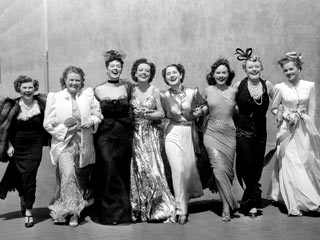
The Women
The film was based upon a play by Claire Booth Luce, and was adapted for the screen by Anita Loos and Jane Murfin. The sets were glorious — designed by Cedric Gibbons; and the women themselves were utterly divine — dressed by Adrian. Adrian’s designs were highlighted in a Technicolor fashion show sequence which was frequently cut from modern screenings. With the exception of the fashion parade the film was shot in B/W. I would love to have seen Norma Shearer’s famously “Jungle Red” fingernails in color, but that is something left to the imagination. There is a NARS lipstick in Jungle Red that may be fun to try.
Because Anne’s book is so delightful, I’m going to share bits of it here on a regular basis. I don’t know about you, but I can always use beauty advice, even if it is 70 years old! Get ready to “Kiss and Make Up” — the topic which begins Rodman’s book.
